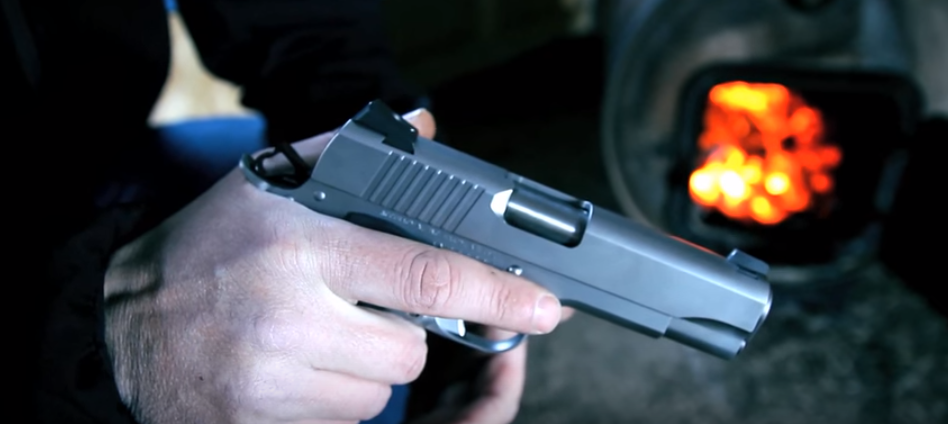Who saids the 1911A is Inaccurate?
[su_heading size=”30″]The GI’s of WWII Claimed the 1911’s were Inaccurate![/su_heading]
There are numerous stories of GI’s returning from World War II complaining about the inaccuracy of the 1911A1, and since the 1911 can be one of the most accurate combat handguns why not put this myth to the test.
Luckily, great minds think a like Dave Royer and Larry Vicker put together a test to debunk this myth. So they pitted an actual WWII US .45 cal with WWII 45 ACP ammunition against Larry’s custom Colt 1911. Doesn’t sound fair but let’s wait to see the footage of the test.
Results
Though there were some differences with the equipment on the custom Colt 1911 that Larry used, the accuracy of the weapon were similar for both 1911s. We can speculate that the “skill set just wasn’t there for the soldiers that were using it”. So if these soldiers were better trained on the 1911, the negative sentiments would have been different.
[su_heading size=”30″]Video Transcription[/su_heading]
Larry: Ok, the next myth that my buddy Dave Royer and I are gonna explore is the myth of 1911 A1 inaccuracy. This is something Dave asked me and Ken Hackathorn many years ago, so Dave, give us your spin on this.
Dave: Well, any history buff knows, reading about World War Two, WWII GIs coming back talked about the inaccuracy of the 45, and that was hard for me to believe, so when I got together with you and Ken, I asked about it, we took out a World War 2 45 and tested that myth.
Larry: We’re gonna recreate that here at Gunsight. Dave and I are gonna get a couple of targets up, we’re gonna back up to twenty yards. Dave’s gnna take the WWII Remington Rand, with a US GI WWII magazine, and WWII 45 ACP ammunition. I’m gonna take my custom Colt that I recently built in the TAC TV 1911 pistolsmith class, beginning of season 2, and we’re both gonna shoot a group here at twenty, and see how they compare between the two of ’em. Goin’ hot.
Alright, Dave, when you’re ready: one magazine’s worth, at your target, center mass.
Dave: Ok.
[Shooting]
Larry: Alright Dave, good to go.
Alright, Dave, now I’m gonna try my magazine’s worth, on target 11, center mass.
Dave: Alright.
[Shooting]
Dave: Got a real nice group there.
Larry: Alright, dude, let me holster, and we’ll be down, check it out.
Alright, Dave, talk me through your group here, bro, doesn’t look too bad.
Dave: Not too bad. A big difference on this is the stock sights, the rear sight doesn’t have much of a notch in it at all. The front sight’s real thin, trigger’s not bad, stock-grade, but it’s heavy.
Larry: Yeah, it’s a little on the heavy side.
Dave: But more than accurate enough.
Larry: Well as we’ve said in the past, you can take a WW2 1911, put better sights, and lighten up the trigger a little bit better and actually you got a pretty damn good combat handgun.
Dave: Oh absolutely. It was a real treat for me today to come out here and do that. World War Two gun, WWII mag, you surprised me wit hthe ammo, I didn’t know I was gonna have World War Two ammo, but we had the whole setup, so it was a treat for me to shoot this today.
Larry: We talked about the main limitation today, in WWII they were training millions of guys, and they had enough ammunition, enough time essentially, to give guys familiarization training with a handgun. Handgun is most difficult of all small arms to master, so therefore guys came away from it thinking the gun was inaccurate. In reality, the gun was definitely more accurate than it needed to be for the given task, the skillset just wasn’t there for the soldiers that were using it.
Now, over here, we shot my gun. Better sights, better barrel, better fitting, better trigger, and you can see the group is at least half, which is no surprise at all. Twenty yards, he shot eight shots, I shot seven shots because I was using a Wilson-Rogers magazine, but regardless, WWII myth of the 1911 being inaccurate for combat is exactly that– a myth. With proper training, that gun will more than accurately get the job done.
Okay, now the next myth that we’re gonna talk about is that you can’t stop the slide on auto-loading weapons. This is a myth that my buddy Ken Hackathorn taught me many years ago, that if you firmly grasp it you can turn it into a single-shot weapon. From a self-defense point of view, Dave, where is the relevancy to that?
Dave: Well if you’re the person with the weapon, you have one shot to get off. If you’re gonna use the weapon after that, you have to get the weapon away, rack the slide to put another round in.
Larry: Ok, now, if you’re struggling with an assailant, and somebody grabs your slide, you need to be aware of that, because now you have a single-shot weapon.
Dave: Correct. And if you don’t let it go, he can’t fire another round off.
Larry: Exactly. Let me show you what I’m talking about, here. Got my 1911 up, loaded and ready to go. You firmly grasp the slide [shot] and now it turns into a single-shot weapon. See I can’t pull the trigger, I can’t fire again. At this point, I have to cycle the slide and kick out the empty case before I fire the weapon again. So you’ve effectively turned it into a single-shot weapon. Remember: You’re struggling with somebody with a gun, that may come to your advantage, or that may work against you, and you need to be aware of that.
Source: TAC-TV, Vickers Tactical



